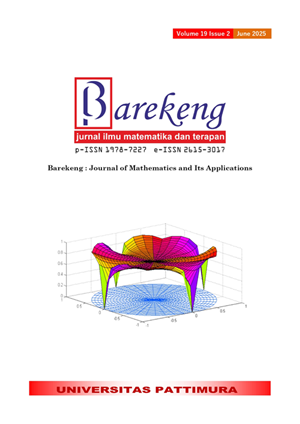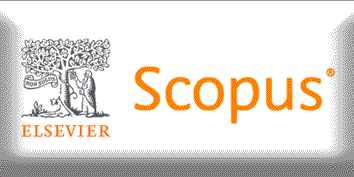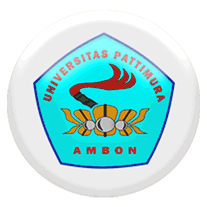GEOGRAPHICALLY WEIGHTED PANEL REGRESSION MODELING OF POVERTY RATES IN TROPICAL RAINFOREST AREAS OF KALIMANTAN
Abstract
When applied to spatial panel data, the Geographically Weighted Panel Regression (GWPR) model is a localized version of the linear regression model. The Fixed Effect Model (FEM) inside estimator is used as a global model in this investigation. The purpose of this research is to obtain a GWPR model and identify the variables that affect the proportion of the impoverished in 56 districts and cities located in Kalimantan's humid tropical forest region between 2019 and 2022. The Weighted Least Square (WLS) approach, which provides geographic weighting in addition to the Least Square method, is used for estimating the parameters of the GWPR model. The optimal weighting function chosen from the adaptive bisquare, adaptive tricube, and adaptive gaussian weightings is the spatial weighting function used in the GWPR model estimate in this work. For determining the ideal bandwidth, the Cross Validation (CV) criterion is applied. According to the study's findings, the optimal weighting function is adaptive gaussian, which yields the best GWPR model with a CV of 8.8740 at the lowest. The GWPR model parameters were tested, and the results showed that both local and global influences affect the percentage of the population living in poverty. The gross domestic product (GDP), the open unemployment rate, the average length of education, the number of workers, and life expectancy are local factors that affect the percentage of the poor; on the other hand, the number of workers is a global factor that affects the percentage of the poor.
Downloads
References
D. C. Wati and H. Utami, “MODEL GEOGRAPHICALLY WEIGHTED PANEL REGRESSION (GWPR) DENGAN FUNGSI KERNEL FIXED GAUSSIAN PADA INDEKS PEMBANGUNAN MANUSIA DI JAWA TIMUR,” Jurnal Matematika Thales, vol. 2, no. 1, pp. 78–7, Jul. 2020.
N. M. S. Ananda, S. Suyitno, and M. Siringoringo, “Geographically Weighted Panel Regression Modelling of Human Development Index Data in East Kalimantan Province in 2017-2020,” Jurnal Matematika, Statistika dan Komputasi, vol. 19, no. 2, pp. 323–341, Jan. 2023.
A. Salsabila Rahman, G. Maria Tinungki, and E. Tri Herdiani, “Robust Geographically Weighted Regression Model on Poverty Data in South Sulawesi in 2019,” International Journal of Research Publications, vol. 131, no. 1, Aug. 2023.
Deviani, B. Y. Wulandari, Askariyah, I. J. Fitri, and S. Hariati, “ANALISIS SPASIAL BERBASIS PEMETAAN MENGGUNAKAN GEOGRAPHICALLY WEIGHTED REGRESSION (GWR) PADA SEBARAN JUMLAH WISMA DI KABUPATEN LOMBOK BARAT,” vol. 5, no. 2, 2024.
BPS, DATA DAN INFORMASI KEMISKINAN KABUPATEN/KOTA DI INDONESIA. Jakarta: Badan Pusat Statistik, 2022.
R. N. Safitri, S. Suyitno, and M. N. Hayati, “Penerapan Model Mixed Geographically Weighted Regression dengan Fungsi Pembobot Adaptive Tricube pada IPM 30 Kabupaten/Kota di Provinsi Kalimantan Timur, Kalimantan Tengah dan Kalimantan Selatan Tahun 2016,” EKSPONENSIAL, vol. 11, no. 2, p. 107, Jan. 2021.
R. Ridhawati, S. Suyitno, and W. Wasono, “Model Geographically Weighted Poisson Regression (GWPR) dengan Fungsi Pembobot Adaptive Gaussian,” EKSPONENSIAL, vol. 12, no. 2, p. 143, Dec. 2021.
S. M. Meutuah, H. Yasin, and D. A. I. Maruddani, “PEMODELAN FIXED EFFECT GEOGRAPHICALLY WEIGHTED PANEL REGRESSION UNTUK INDEKS PEMBANGUNAN MANUSIA DI JAWA TENGAH,” JURNAL GAUSSIAN, vol. 6, no. 2, pp. 241–250, 2017.
A. Asnita, S. Sifriyani, and M. Fauziyah, “ESTIMATION OF GEOGRAPHICALLY WEIGHTED PANEL REGRESSION MODEL WITH BISQUARE KERNEL WEIGHTING FUNCTION ON PERCENTAGE OF STUNTING TODDLERS IN INDONESIA,” BAREKENG: Jurnal Ilmu Matematika dan Terapan, vol. 18, no. 1, pp. 0383–0394, Mar. 2024.
T. A. Prasanti, T. Wuryandari, and A. Rusgiyono, “APLIKASI REGRESI DATA PANEL UNTUK PEMODELAN TINGKAT PENGANGGURAN TERBUKA KABUPATEN/KOTA DI PROVINSI JAWA TENGAH,” JURNAL GAUSSIAN, vol. 4, no. 3, pp. 687–696, 2015.
A. Pamuji, E. P. Setiawan, and A. M. Munir, “Regresi Data Panel dalam Analisis Faktor-Faktor yang Mempengaruhi Tingkat Pengangguran Terbuka di Provinsi Daerah Istimewa Yogyakarta Tahun 2017-2021,” Indonesian Journal of Applied Statistics, vol. 6, no. 2, p. 162, Apr. 2024.
A. Pratama, S. Suyitno, and I. Purnamasari, “PEMODELAN PERSENTASE PENDUDUK MISKIN DI PROVINSI KALIMANTAN TIMUR MENGGUNAKAN MODEL GEOGRAPHICALLY WEIGHTED PANEL REGRESSION,” Jurnal MSA ( Matematika dan Statistika serta Aplikasinya ), vol. 9, no. 2, Dec. 2021.
S. Sifriyani, I. Mandang, F. D. T. Amijaya, and R. Ruslan, “DEVELOPING GEOGRAPHICALLY WEIGHTED PANEL REGRESSION MODEL FOR SPATIO-TEMPORAL ANALYSIS OF COVID-19 POSITIVE CASES IN KALIMANTAN, INDONESIA,” Journal of Southwest Jiaotong University, vol. 57, no. 3, pp. 113–126, Jun. 2022.
S. Martha, Y. Yundari, S. W. Rizki, and R. Tamtama, “PENERAPAN METODE GEOGRAPHICALLY WEIGHTED PANEL REGRESSION (GWPR) PADA KASUS KEMISKINAN DI INDONESIA,” BAREKENG: Jurnal Ilmu Matematika dan Terapan, vol. 15, no. 2, pp. 241–248, Jun. 2021.
Sutro, Yundari, and S. Martha, “PEMODELAN FIXED EFFECT GEOGRAPHICALLY WEIGHTED PANEL REGRESSION UNTUK INDEKS PEMBANGUNAN MANUSIA DI KALIMANTAN BARAT,” Buletin Ilmiah Math. Stat. dan Terapannya (Bimaster), vol. 09, no. 3, pp. 413–422, 2020, doi: https://doi.org/10.26418/bbimst.v9i3.41097.
A. Rusgiyono and A. Prahutama, “GEOGRAPHICALLY WEIGHTED PANEL REGRESSION WITH FIXED EFFECT FOR MODELING THE NUMBER OF INFANT MORTALITY IN CENTRAL JAVA, INDONESIA,” MEDIA STATISTIKA, vol. 14, no. 1, pp. 10–20, Jun. 2021, doi: 10.14710/medstat.14.1.10-20.
F. C. Ninda, L. Dinayanti, and S. M. Berliana, “Pemodelan Geographically Weighted Panel Regression (GWPR) pada Rumah Tangga yang Menempati Rumah Kumuh di Indonesia Tahun 2020—2022,” Seminar Nasional Official Statistics, vol. 2024, no. 1, pp. 947–958, Nov. 2024, doi: 10.34123/semnasoffstat.v2024i1.2028.
Copyright (c) 2025 Ghina Fadhilla Mumtaz, Suyitno Suyitno, Sifriyani Sifriyani

This work is licensed under a Creative Commons Attribution-ShareAlike 4.0 International License.
Authors who publish with this Journal agree to the following terms:
- Author retain copyright and grant the journal right of first publication with the work simultaneously licensed under a creative commons attribution license that allow others to share the work within an acknowledgement of the work’s authorship and initial publication of this journal.
- Authors are able to enter into separate, additional contractual arrangement for the non-exclusive distribution of the journal’s published version of the work (e.g. acknowledgement of its initial publication in this journal).
- Authors are permitted and encouraged to post their work online (e.g. in institutional repositories or on their websites) prior to and during the submission process, as it can lead to productive exchanges, as well as earlier and greater citation of published works.






1.gif)



